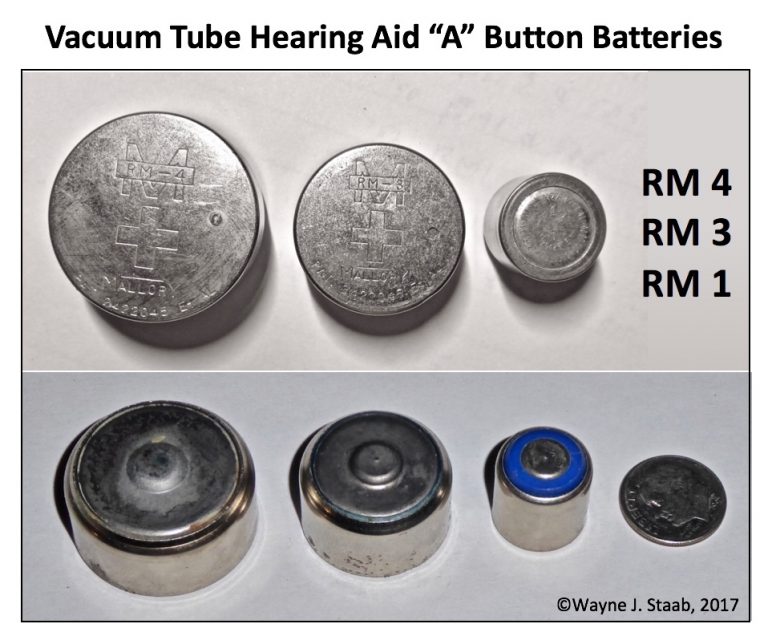Vintage Hearing Aid Batteries
Reprinted with permission from HearingHealthMatters.org
In researching vintage hearing aid batteries, occasional references are made to the power supplies (batteries) used. However, for most individuals, never having been exposed to out-of-date hearing aids, there is little reason to expect to know what some of the sizes and types were.
This post will review some of the commonly-used batteries and cells at the time, but which are not generally found today. This is a continuation of an historical overview of hearing aids in the earlier vacuum tube era. Considerable text explains the early hearing aids, but not much is available identifying the power supplies used. That is one purpose of this post.
Much credit for the development of smaller hearing aids that could be head-worn, has been attributed to the development of the transistor, over vacuum tubes, which required only a single battery and lower voltage. However, battery companies were always looking to reduce the size and efficiency of their products, including those for hearing aids.
Companies that produced batteries for hearing aids in the early 1950s were National Carbon Co. (Union Carbide), P.R. Mallory and Co., Ray-O-Vac Co., General Dry Batteries, and Burgess Battery Co. To the best of my knowledge, there are only three major companies remaining that manufacture hearing aid batteries.
Vacuum Tube Hearing Aid Batteries
Vacuum tube hearing aids required two batteries, a 1.5 volt “A” battery that powered the vacuum tube filaments, and a higher voltage “B” battery to power the plate circuit to amplify the sound. A few very early “A” batteries were reported to be 3 volts, but the most common, and that which was last used for vacuum tube hearing aids was 1.5 volts (not the 1.4 volt batteries that many are familiar with and which were used with transistor hearing aids). Some very early vacuum tube hearing aids used “B” batteries as high as 90 volts. “A” batteries were used at a rate of approximately 2 or 3 times greater than “B” batteries.
Early vacuum tube hearing aids consisted of a two-pack (or multi-pack) arrangement; one pack for the hearing aid (microphone and amplifier), and the other for the two batteries.
“B” Batteries
Technology that permitted making better and smaller vacuum tubes led to size and power reduction. This size reduction led to the monopac body-worn hearing aids, where the microphone, amplifier, and power supply were all housed within the same hearing aid case (Figure 1).

Figure 1. Beltone Monopac body-worn hearing aid (1944). This instrument captured all the hearing aid components into one case, with the exception of the receiver which delivered the signal via a cord to the ear. The monopac allowed for the user to carry one package, rather than two. Previous hearing aids had a separate pack for the batteries, and another for the hearing aid.
The reduction in vacuum tube size permitted a similar reduction in battery voltage needs, therefore leading to smaller battery sizes. As an example, the first vacuum tube hearing aids mostly required at least 45 volts for the “B” battery. This later dropped to 30 volts, to 22.5 volts, and then to 15 volts. Examples of some of the earlier “B” batteries, along with their identification and voltage are shown in Figure 2. Once the transistor came into use, and/or when mercury replaced carbon-zinc as the active ingredient in batteries, button-type cells began to emerge. Unlike today, during the 1940s, 1950s, and even into the 1960s, hearing aid companies often had special sizes and shapes for batteries used in their products. In reviewing hearing aid batteries during that time period, at least 60 different battery sizes and shapes were used. Although some were interchangeable, many were not.

Figure 2. Size reductions in the hearing aid “B” battery over time. These reductions coincided with improvements in battery technology and with the reduction in size of the vacuum tubes used in the hearing aids. The battery numbers below each of the menu categories have the same voltages as shown above the batteries, but often had different shapes and contacts.
“A” Batteries
The “A” battery saw changes in its size as well, as shown in Figure 3. These changes consisted primarily in size reduction, with essentially all being of 1.5 volts. Both the button-cell type on the right and those on the left were used during the same time frame. Just as with “B” batteries, a number of different designations existed for the “A” battery. Just a few of these included: 1035, Z-1PL, RM-4, RM-3, RM-1, Z-225, RG-1, RG-3, 1015E, 1016E, M10H, No. Z, Z-1M, M-910H. The size and shape of the “A” battery was often determined by the design configuration of the hearing aid.

Figure 3. “A” battery size and shape examples used with vacuum tube hearing aids. Some were a button-type cell, as shown on the right. A 2017 behind-the-ear hearing aid is shown on the extreme right to provide a reference as to sizes. These are all 1.5 volt batteries used for vacuum tube hearing aids, not the 1.4 volt batteries used later in hearing aids using transistor circuitry.
Only partial transition occurred from taking the “A” battery from paper-wrapped to metal-cased button cells. Figure 4 shows the major “A” battery button cells that were used in vacuum tube hearing aids. Those shown were manufactured by P.R. Mallory Co. of North Tarrytown, NY. They produced the Mallory RM-4, Mallory RM-3, and the Mallory RM-1. All three are 1.5 volts. These were used in vacuum tube hearing aids in the late 1940s and early 1950s. Following the introduction of transistor hearing aids, the RM-1 was sometimes used as the power supply for the hearing aid.

Figure 4. Mallory RM button batteries. These were all 1.5 volts and were used as the “A” battery in many hearing aids in the late 1940s and early 1950s. The RM-4 was the largest button battery made for hearing aid use. It weighed 1.6 oz. (45 grams) and measured 30 mm in diameter and had a height of 17 mm. The RM-3 was 25 mm in diameter and had a height of 16 mm. It weighed 1 oz. (30 grams). The RM-1 measured 15.5 mm in diameter and had a height of 16 mm. It weighed 0.4 oz. (10 grams). It is not clear if a RM-2 existed for hearing aids. A very small hole on the positive side of the RM-4 and RM-3 acted as a valve to relieve excess pressure that could be built up when the battery was being used. The bottom images represent the underside of the batteries shown on the top section.
Button Batteries
Button batteries (cells) came into extensive use with the introduction of mercury as an active ingredient in hearing aid batteries. They started with the “A” batteries introduced by Mallory, but transitioned to the single power source following the wide use of transistors in hearing aids. Shapes and designations of just some of these are shown in Figure 5. In some cases, button batteries were stacked, or doubled up into a single package, as shown in Figure 6. That package consists of two RG-1 (RM-1) batteries soldered together and covered with paper to represent a single battery. Some hearing aids just put two of these back-to-back in the same battery compartment slot.

Figure 5. Shapes and size reductions in button cells used in hearing aids, with an attempt to show when they started being used in hearing aids. This is not a complete listing, but only features the most common. The three largest (RM-4, RM-3, and RM-1) are Mallory “A” button cells. To the right of these three “A” batteries, and curling around are the single power supply cells used following wide-spread user of transistors in hearing aids. These replaced both the “A” and “B” batteries. As single power supply cells, they no longer carried the designation of “B” batteries. None of these were zinc-air cells.

Figure 6. This Zenith ZB-1 (a guess based on the inability to determine what might have been printed in the space of the paper split) battery consists of two RG-1 (General Battery Co.) batteries soldered together and covered with paper to serve as a single battery. The voltage is 2.6.
Batteries for Early Transistor Hearing Aids
The previous section was about early vacuum tube and transistor hearing aids, and the hearing aid batteries they used. A tremendous change occurred in hearing aid size in going from vacuum tubes to transistors as amplifiers. Much of that related to changes in the battery size as well, as previously discussed.
This post is intended to show how some of these batteries actually looked as attached and/or inserted into hearing aids, and how these changes occurred over time, especially during the late 1940s and into the 1950s.
Battery Supply for Vacuum Tube Hearing Aids (1942 Product)
These are generally the images shown in any discussion about the history of hearing aids. This post will not overdo this, but instead show how these power supplies operated with one of the author’s old boxed-up hearing aid collection units.
Zenith A2A
The Zenith A2A was an early two-part hearing aid (Figure 7). Part one consisted of the hearing aid, and part two consisted of the two large batteries required to operate the hearing aid. The batteries were often contained in the same pack (pack shown in the right image in Figure 1 and shown in intended use in Figure 8.

Figure 7. This 2-pack 1942 Zenith A2A hearing aid is a 2 vacuum tube amplifier. It uses a 1.5 volt “A” battery (not shown attached on the left image, but intended to be attached to the two-prong plug), and a 30 volt “B” battery (430-P). The consumer of this aid had obviously replaced the Zenith brand battery with a comparable voltage and same plug arrangement. The hearing aid is one part of the 2-pack system, and the batteries collectively constitute the second part of the 2-pack system. The batteries were most often contained in the same pack. This instrument was called the “Radionic Hearing Aid.” Zenith had its own labeled brand of batteries as seen in the right image, but many different “A” and “B” batteries could be used as long as they had the appropriate plugs and voltages.

Figure 8. Battery pack suggestions for women as provided by Zenith Radio Corporation for its A2A body-worn hearing aid owner’s manual.
Battery Supply for Vacuum Tube Hearing Aids (1946 Product)
By 1946, both the vacuum tubes and batteries had been reduced in size, as shown in Figure 9 and were housed in the same package (minus the receiver). This included both the “A” and “B” batteries.

Figure 9. Beltone Harmony 3-vacuum tube hearing aid of 1946. This image shows the hearing aid with the round RM-4 “A” battery and a 30 volt “B” battery (in this case the Eveready 413E). This unit used a crystal microphone, as identified by the green dot on the right above the battery opening. The unit measured 108 x 70 x 24 mm.
Beltone Harmony (1946)
The Beltone Harmony hearing aid shown in Figure 9 is such a monopac. This vacuum tube hearing aid contained a RM-4 “A” battery and an Eveready 413E “B” battery in the same case as the remainder of the electronics.
Battery Supply for Vacuum Tube Hearing Aids (1947 Product)
By 1947, body-worn hearing aids had made continued improvements in vacuum tube size and lower battery power requirements.
Acousticon A 90M (1947)
Figure 10 shows the Acousticon A 90M body-worn hearing aid. This hearing aid still used the 1.5-volt RM-4 “A” battery, but the “B” battery voltage had dropped to 15 volts. This hearing aid was slightly smaller in size than the Beltone Harmony of just one year earlier, showing that even small changes in size was a design goal.

Figure 10. The Acousticon A 90M vacuum tube body-worn hearing aid of 1947 was made by Dictagraph Products of New York. This used a RM-4 “A” battery (1.5 V) and a 15 volt “B” battery. Although smaller that most previous body-worn hearing aids, it still measured 105 x 60 x 22 mm in size.
Battery Supply for Vacuum Tube Hearing Aids (1950 Product)
Microtone T-10 or Microtone “Ten” (1950)
This was a rechargeable hearing aid using 3 vacuum tubes. It was powered by a RM-1 “A” battery and a 504 “B” battery (Figure 11). It was identified also as “Sealed Power.” This hearing aid had a Sterling Silver case and came with a dresser top storage case that had a battery tester called the “Micro-Mizer.”

Figure 11. Microtone T-10 Sterling Silver hearing aid and its “Micro-Mizer” A/C powered battery tester. The battery tester had two slots for testing and reconditioning the two different hearing aid batteries. Their voltages were measured on the same voltage scale on the meter. It had a scale for the “A” battery and another for the “B” battery. Each was tested separately using a “Test” button on the tester. The range of the “A” battery was from 0 to 2 volts. That for the “B” battery ranged from 0 to 50 volts. The Micro-Mizer was used to place the batteries in overnight to “recondition” following daily use. It was advertised that by doing so, the effective life of the “A” battery could be extended by 3 to 4 times, and the “B” battery up to 5 times its normal life. It was recommended that the user have two sets of batteries so that one set could be “reconditioned” while the other set was being used.
Battery Supply for Vacuum Tube Hearing Aids (1951 Product)
Continued size reduction, but with increased power was a design feature in the early 1950s.
Zenith Super Royal (1951)
A good example is the Zenith Super Royal in 1951 (Figure 12). This was one of the last vacuum tube hearing aids (3 vacuum tubes) made by Zenith, changing to transistorized hearing aids in 1953. This unit was unique in that it used four batteries: two 1.5 volt “A” batteries (Zenith size 222, same size as RM-1), and two 15-volt “B” batteries. Only one of the “A” batteries was in use at any given time, with the user periodically switching between the two “A” batteries (switch on the top of the aid – A1-A2) to provide some recovery while the other was being used. The “B” batteries (22.5 V) were connected in series to produce 45 volts for increased output power.

Figure 12. Zenith Super Royal 3 vacuum tube hearing aid of 1951. This hearing aid was unique in that it used four batteries. It had two “A” 1.5 volt batteries and two 22.5 volt “B” batteries, which were wired in series to produce 45 volts for added output power. It measured 113 x 59 x 22 mm in size. This shows the two RM-1 batteries in place, but only one of the 22.5 volt batteries.
Batteries from Early Transistor Hearing Aids
The transition from vacuum tube to transistor hearing aids occurred in the mid 1950s. The transistor allowed for a single power supply, and voltage as low as 1.4.
Being able to operate on 1.4 volts reduced tremendously the power requirements, both in size and required voltage from that required for vacuum tube hearing aids. Essentially all hearing aids made this transition during this period. Two, from the same company, that served as examples of how a smaller- sized power supply was used were the Zenith Model 75-X and the Zenith Regent (Figure 1). Both used a 1.4 volt 401 battery; the Model 75-X using a single battery, and the Model Regent using two 401 batteries.
Zenith 75-X (1954)
The Zenith “75-X” used a Zenith “N” size 1.4 volt. This was Zenith’s label for the 401 battery. The hearing aid was a 3-transistor amplifier housed in a chrome case (some say polished aluminum). It measured 65 x 45 x 18 mm. It used a single 401 battery. The hearing aid was manufactured by what was then a Division of Zenith Radio Corporation, Zenith Hearing Aid Division. The reason for the model number was that the recommended cost to the consumer by Zenith was $75 – something not looked upon favorably by those selling the product.
Zenith Regent (1955)
The Zenith “Regent” transistor hearing aid was a 5-transistor aid of a push-pull (PP) amplifier type. It measured 81 x 45 x 17 mm in size, and consumer cost was designated at $195. This unit used two 401 batteries (Figure 13).

Figure 13. Early hearing aids that used the 401, 1.4-volt battery (Zenith N-Cell), were the Zenith “75-X” and the Zenith “Regent.” The reason for the two batteries related to the output power, with the “Regent” providing a very high output of 142 dB SPL.
Sonotone 200 Transistor Body-Worn Hearing Aid (1956)
The Sonotone 200 was a 4-transistor push-pull hearing aid. It measured 76 x 45 x 16 mm in size (Figure 14). The hearing aid had discrete-position sliding switches, shown above the battery. The left control is a 4-position power control. The center control is a 2-position low-pass filter. The right control is a 2-position high-pass filter. The battery was a Sonotone 600 battery of 2.8 volts. This was essentially two 401 batteries in the same plastic housing, soldered together in series. This can be visualized better in Figure 15.

Figure 14. Sonotone 200 4-transistor body-worn hearing aid. This was powered by a 2.8-volt battery package. The controls above the battery were, from left to right: 4-position power control, 2-position low-pass filter, and a 2-position high-pass filter. These were adjusted by the hearing aid dealer.

Figure 15. Examples of smaller batteries used with transistor hearing aids. On the left is a General mercury 2.6-volt battery. The plastic-shelled battery in the center is actually two 401 (1.4 volt) batteries soldered together to generate a series connection to provide 2.8 volts. An example of this was the Sonotone 600 battery. It generated 2.8 volts. The two batteries on the right were early 401 (1.4 volt) mercury batteries for transistor hearing aids by Mallory and Eveready.
This post completes the series on vintage hearing aids and batteries found in the author’s garage in an old box. What was reported in this series did not attempt to provide a detailed history of development, but to highlight some of the unique features of hearing aids found in that box. In this way, the intent was to help preserve part of the history of hearing aids, especially of those in the late 1940s and through the mid 1950’s.
The views and opinions expressed in posts do not necessarily state or reflect those of Hearing Health and Technology Matters, LLC. Articles may be republished with permission of the Editor of HHTM. Please read our republication guidelines before submitting your request. Copyright © Hearing Health & Technology Matters, LLC. 2017. All rights reserved.

